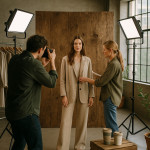Writing a corporate portrait brief that humanises leadership without clichés
A precise portrait brief is the difference between stiff, copy-paste headshots and images that reveal authentic leadership. Follow this guide to frame expectations, inspire your photographer and secure portraits that feel human—without drifting into tired visual clichés.
Why crafting a thoughtful brief matters

Corporate portraits travel further than annual reports. They live on investor decks, social media banners, media kits and your brand's public photographer directory. An unclear brief forces the team to guess, which often results in generic smiles against grey backdrops. Clarity saves reshoots, protects budgets and amplifies brand storytelling.
Pre-brief groundwork: know the story you want to tell
Audit existing leadership imagery
Gather current portraits and analyse what works and what feels dated. Are all leaders in identical poses? Do backgrounds match brand colours? Note gaps before briefing.
Define audience and platforms
- Investor relations website: needs authority and approachability.
- Recruitment campaigns: should highlight diversity and warmth.
- Thought-leadership articles: call for personality and context.
Align visual tone with corporate values
If innovation is a core value, portraits can integrate lab or product settings. If sustainability leads the narrative, consider natural light and eco-friendly sets—tips you'll also find in sustainable portrait shoot guidelines.
Core components of a humanising corporate portrait brief
- Objective statement. One sentence that explains why the portraits are required now.
- Key messages. Three traits each image should convey (e.g., transparency, expertise, empathy).
- Visual references. Attach mood boards or link to examples; see how to build them in this mood-board article.
- Environment guidelines. Real workplaces over studio backdrops; avoid “arms-crossed against skyline” trope.
- Wardrobe and grooming cues. Offer palettes, not costumes. Encourage leaders to choose items they often wear.
- Authentic prompts. Instead of “smile,” brief the photographer to ask leaders about recent wins or future ideas to spark natural expressions.
- Diversity lenses. Schedule sessions that accommodate mobility needs and different cultural grooming habits.
- Usage rights & file specs. Detail resolutions, crops and licence period—templates inside this rights checklist.
Common clichés and how to replace them
| Clichéd request | Humanised alternative |
|---|---|
| “Fold your arms and look confident.” | “Hold an object that represents your role—prototype, tablet, blueprint.” |
| Identical grey backdrop for all leaders | Contextual workspaces that differ by department |
| Harsh rim light for ‘dramatic' effect | Soft daylight near windows to evoke openness |
| Photoshop-brightened eyes | Genuine engagement: prompt leaders to talk about a passion project |
Directing without dictating: collaboration tips

Briefs should empower, not micromanage. Invite the photographer to pitch angles: maybe a low vantage point for the CEO in an innovation lab or candid hallway shots for department heads. If your team is scattered worldwide, share remote tethering workflows to maintain creative alignment.
Interview mini-sessions
Set aside five minutes per leader for informal questions. Candid laughter or thoughtful pauses captured mid-conversation often outperform posed smiles.
Inclusive scheduling
Offer early-morning, midday and late-afternoon slots. Flexibility respects diverse commitments and leads to relaxed faces.
Timeline and budget anchors
- Pre-production (1 week): location scout, test shots, wardrobe confirmation.
- Shoot days (2 days): allocate 45 minutes per leader, including setup tweaks.
- Post-production (1 week): basic colour grading, light retouching (skin texture intact).
Hidden costs can derail shoots—travel, overtime, file delivery fees. Budget buffers using advice from multi-location budgeting guidelines.
Deliverables & usage rights
Spell out required ratios (1:1, 4:5, 16:9) and file names (lastname_role_1x1.jpg). Secure worldwide digital use for five years, plus optional print licence. Request layered files for future colour tweaks.
Final checklist before hitting “Send”
- Objective sentence clear?
- Three desired traits listed?
- Mood board attached?
- Inclusive scheduling proposed?
- Usage rights unambiguous?
- Contact person and approval timeline included?
Quick knowledge quiz
FAQ
- How long should a corporate portrait brief be?
- Aim for one to two pages plus visual references. Brevity keeps focus while covering essentials.
- Is retouching always necessary?
- Basic colour balance and blemish removal are standard. Heavy retouching can undermine authenticity.
- Can we reuse portraits across campaigns?
- Yes—if your licence covers the intended channels and time frame. Confirm before distribution.
- What if leaders dislike being photographed?
- Share the brief early, allow them to choose settings and schedule practice shots to ease nerves.
- How often should we update leadership portraits?
- Every 18–24 months or when leadership changes, to reflect current branding and personal style.
Ready to brief your next shoot? Apply the checklist above and watch leadership portraits evolve from formalities to engaging brand assets.











